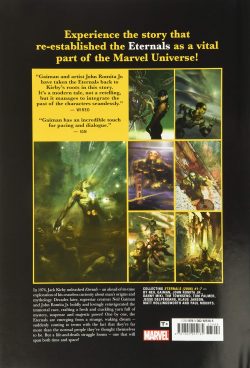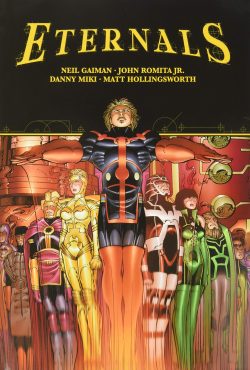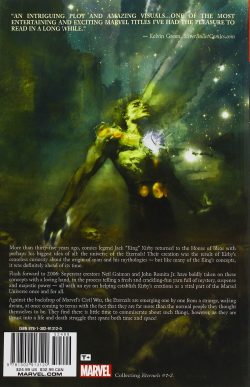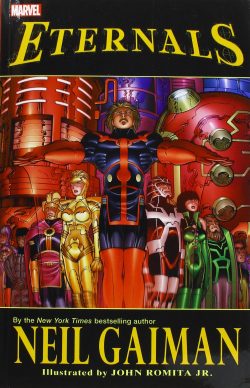



By Neil Gaiman & John Romita Jr. & various
ISBN: 978-1-3029-2518-5 (HB 2020) 978-1-3029-1312-0 (TPB 2018)
Nobody ever did “epic†bigger or better than Jack Kirby. He was – and remains – the most important single influence in the history of American comics. There are millions of words about what the man has done and meant, and you should read those if you are at all interested in our medium. You should also familiarise yourself with all his graphic works.
For a long time after his departure, other creators sought to capitalise on his creation – as I’m sure you’ll soon become aware as the movie momentum takes hold. This particular revival from 2006 is a strikingly enjoyable graphic experience very true to the power and enthusiasm of ‘The King’ and should probably top your wish list, just below the many collected iterations of the original saga.
When the comic series debuted in 1976 we met anthropologist Professor Damien and his daughter Margo whose explorations revealed that giant aliens had visited Earth in ages past: sculpting proto-hominids into three distinct species: Human Beings; the monstrous, genetically unstable Deviants and god-like super-beings who called themselves Eternals. Moreover those humungous Space Gods had returned a few times to check up on their experiment…
Never a comfortable fit with the rest of the Marvel Universe, the comic explored Kirby’s fascinations with Deities, the immensity of Space and potential of Supernature through the lens of very human observers. Once the series ended and Kirby left, other creators eagerly co-opted the concept – with mixed success – into the company’s mainstream continuity.
Now, back to the present collection. When Mark Curry, a struggling hospital intern, meets Ike Harris his delicate mental state seems to fragment. His dreams of monsters and gods return in force, and even though super-powered people are commonplace in a society that mandates that all super-humans register with the government, Harris seems somehow… different. And there are others. Such as Sersi, a cute chick he met at the coffee-shop, or Thena or ever-so-creepy Druig…
For inexplicable but pressing reasons, Harris believes they are all Eternals, built by space-spanning Celestials as caretakers for the planet, but something hidden has deactivated them.
He cannot find any others.
A crisis is brewing.
Without Eternals in the picture, the malignant deviants are on the rise again.
There may be another hidden foe. Harris wants Curry’s help to find those missing guardians…
…And now Mark discovers that he has superpowers too…
Another strand in play is the secret foe’s plan. Someone has somehow excised the entire Eternal race, leaving only these shadowy potential immortals. Although the reason is unclear random clues are beginning to gel. Long ago, the Space-Gods punished one of their own for an unknowable sin by burying him/it deep in the Earth. Now, that sleeping giant is being awakened, an action that will lead to the destruction of all life on Earth…
Kirby and Gaiman are different writers, and frankly their work is generally addressing different readerships. Kirby’s heroes and villains are simplified, pared down archetypes. Whether fighting for us or searching for great things to which an uncomprehending humanity can only guess, they are generally beyond our clay-footed ken. For Kirby, there would always be an Unknown. That’s why there was always a Rick Jones or Margo Damien or Dr. John Watson. Such everyman characters are there to counterpoint, clarify and highlight the wonder. Readers tuned in to have their minds blown.
Gaiman’s forte is personalising those unknowables. Whether Gods, sentient Concepts, fallen Angels or super-humans, he takes us inside their lives and their heads, showing us creatures not dissimilar to ourselves. Our modern world is not happy with mystery and ‘getting to know the real you’ has become a media obsession and industry. And that’s the crucial difference in this book. Pedestrianising the metaphysical isn’t better or worse, it’s just different.
All of which is, I suspect, irrelevant to most readers. Here is a good comic book read that will happily pass most personal taste tests. And I must – saving the best ’til last – utterly rave over the artwork of John Romita Jr. The power and grandeur of his drawing (augmented with inks from Danny Miki, Tom Palmer, Tim Townsend, Jesse Delperdang & Klaus Janson, colours from Matt Hollingsworth, Paul Mounts & Dean White and lettered by Todd Klein) is absolutely breathtaking! Whether a close, veiled look or a panorama of galactic proportions, he produces that mind-grabbing visual to elicit a whispered “Gosh, Wow!†from even the most jaded viewer. Jack would be proud.
Contextualised by an Introduction from long-time Kirby insider Mark Evanier, this mighty tome – available in hardback, trade paperback and digital formats – also includes copious character sketches, original and unused art pencils, a cover and variants gallery by Romita Jr., Rick Berry, Olivier Coipel and more, plus an extensive text feature ‘The Spotlight Interview with Neil Gaiman’ (by John Rhett Thomas), as well as Gaiman’s ‘Eternal Proposal’ and ‘Jack Kirby and the Eternals’: a critical overview by Robert Greenberger, illustrated by the King himself.
© 2019 MARVEL
